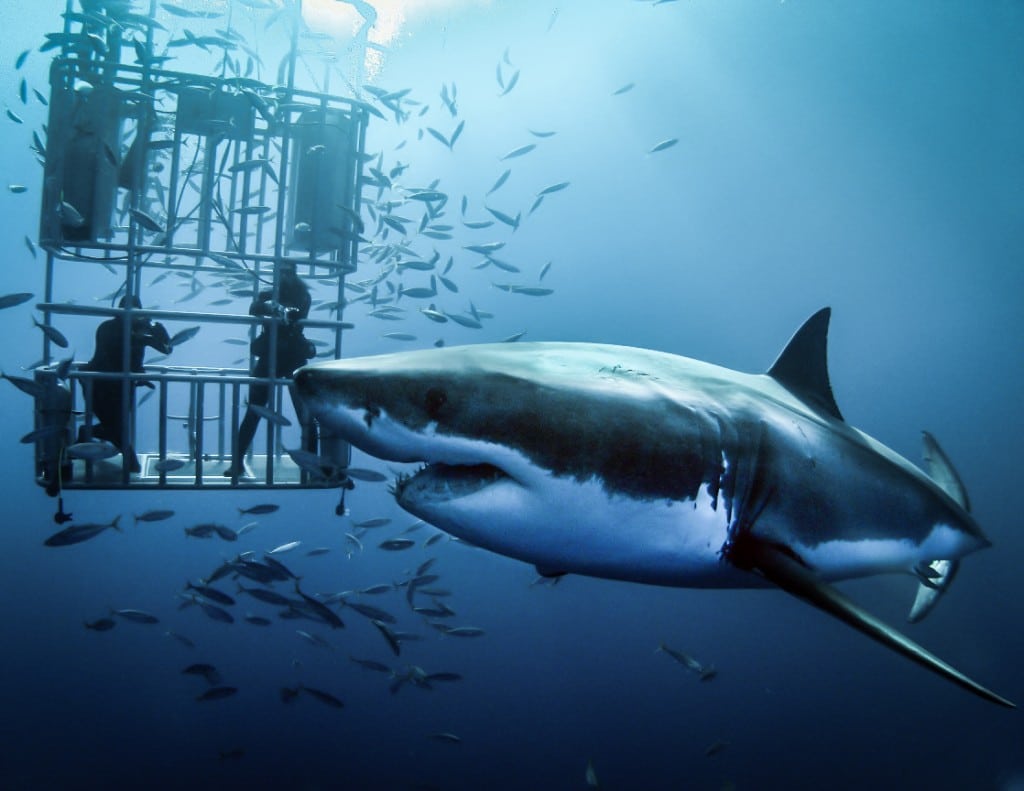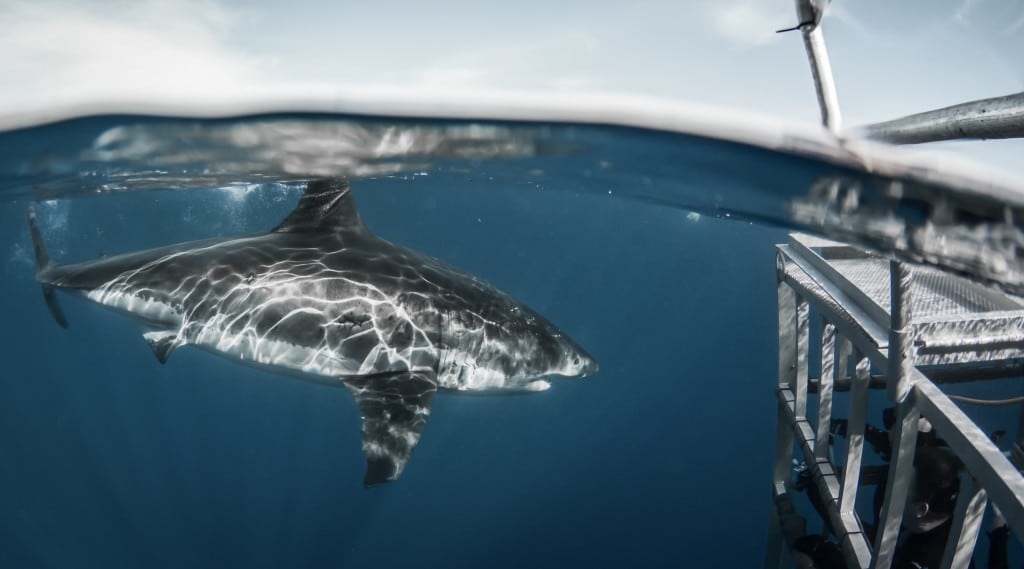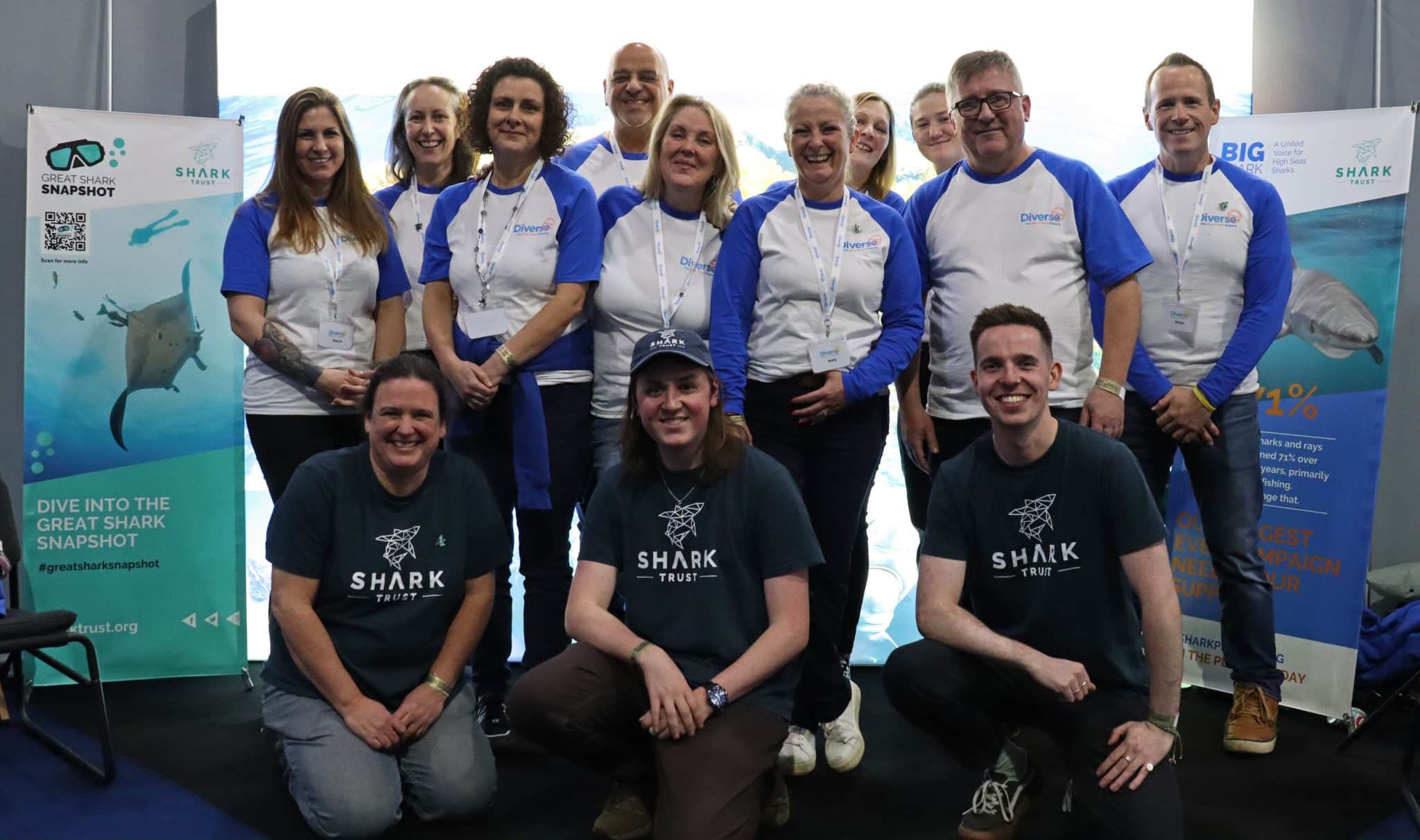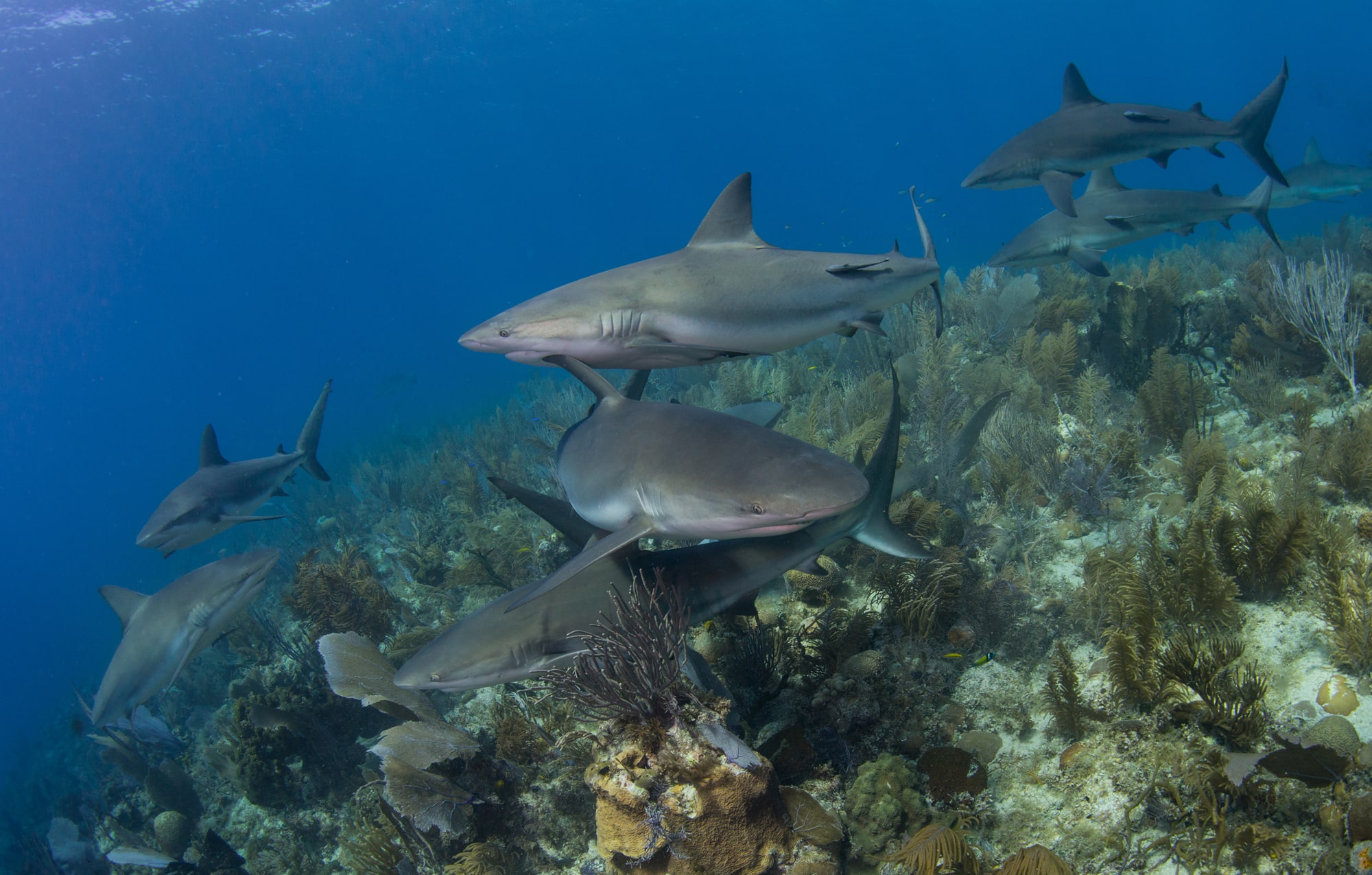Marine Life & Conservation
The Origin and Development of Cage Diving with White Sharks: Part 2

Guadalupe, Mexico
My travels took me to Isla Guadalupe in 2013. 240 km west of the Mexican landmark Baja California lies this small volcanic island. The 32-kilometer-long and eleven-kilometer-wide island is nothing more than a large deserted rock in the Pacific. Uncharted, no fresh water, just a spot on a sea chart. But for divers a paradise. Because Guadalupe is next to South Africa and Australia, it’s a meeting point for the world’s largest predator: Carcharodon carcharias, the Great White Shark!
About 200 animals visit the island each season, of which 155 are known as recurring individuals and therefore have received names from the researchers. All ships have the opportunity to experience the sharks in deep cages, which are lowered to 12 – 15 meters. For the surface cages, bottles are not used in this type of diving, the air supply comes from the mother ship using air hoses on the regulator. Emergency bottles in the cage are available. A special lead system (lead support straps with a lot of lead) is provided to ensure a comfortable and stable position in the cage. Fins are not used. The cages meet the latest and most advanced knowledge of shark research and, of course, meet strict US safety requirements. Safety at the highest level is guaranteed, as is the maximum free view of the sharks, in order to guarantee optimal photos & filming.

The cages can accommodate 2-4 persons. Regular exchanges are self-evident, so that no guest is disadvantaged and the Great Whites can be experienced as often and as close as possible. Up to three animals are circling around my cage at the same time, demonstrating their interest in the divers; they swim close to the cages and touch them gently. The depth cages can also be opened upwards, which makes it possible to leave the cage quickly. There, in 12 – 15 meters of water depth, you are eye-to-eye with the great whites – an indescribable feeling when they slowly rise from the deep towards the cages.
While the depth cages can only be used by certified divers, the surface cages also offer non-divers the opportunity to experience the Great Whites close up. Here too, the crew uses chum and tuna fish heads. But if the sharks do not feel like it, they do not come to the boat either. The first day we waited desperately on board for the predators to come closer to the surface. We could make out their shadows about 20-30 meters below our cages, but that’s about it. If you only have four full dive days and do not see sharks on the first day, you get very disappointed. Especially when you think of the thousands of Euros you have just spend for such a trip. But you are not in the zoo, you are in the wild – nothing can be planned!

During the next days, the sharks became more active. Up to four sharks now circled almost constantly around the cages. Partially so close that I could touch them. But since I wanted to keep my hands, I resisted the temptation.
In Guadalupe, scientists can also dive outside the cage with the white sharks – but only with a permission from the Mexican authorities. Photos of Apnoe divers like Frédéric “Fred” Buyle or Ocean Ramsey are an impressive evidence that white sharks do not necessarily equate humans with food. A few years ago, the free-diving, or rather the diving outside a cage, with other potentially dangerous shark species such as tiger sharks or bull sharks was considered impossible. Today, regular dive trips are organized for everyone to the Bahamas or the Fiji Islands to do just that.

So, what about Guadalupe? From my own experience, I know that out-of-cage diving happens at least since 2012. Again, the internet is full of proof photos. Unofficially and illegally, yes. But also without any attacks on the divers.
Does the cage industry harm the White Sharks?
What about the white sharks themselves? Does commercial cage diving harm the white sharks? It is difficult to assess whether cage diving has already harmed white sharks in the hitherto practiced form. Injuries to sharks during cage diving are from rough handling of the bait when sharks bite in them. The sharks can get tangled and injured in thick ropes, chains, or steel hulls, with which bait and cages are attached, injured from mis-designed cages, sharp metal objects and ship bolts. Even the use of markers (tags), where duck shells and other marine organisms accumulated, already led to serious skin injuries. All these injuries can be avoided by careful planning during cage diving.
Today, cage diving with white sharks is strictly regulated. These laws prescribe exactly what baits you can use and what can be used as chum, how much you can use daily and how to treat the sharks at the boat. Only natural fish products may be tipped into the sea. Mostly, chum is made of mashed up sardines.
“So, no blood, no pig’s heads, cattle, or hated mother-in-law’s”, Craig Ferreira says with a smile.

These rules were introduced to protect the sharks, the environment and tourists. Most people believe when chum is in the water, the sharks come swimming from miles away. This is absolute nonsense. Just as we don’t smell the aroma from a delicious restaurant when the wind comes from the wrong direction, sharks are not being lured in by the chum when the current is unfavorable. The only sharks that are being attracted are the sharks swimming in the chum slick. Sharks, which are one kilometer away or are beyond the chum slick, are not lured to the boat.
Let us look at the facts: White sharks are nomads and swim great distances in the world’s oceans. This means that they are never very long in a particular area. They move continuously along the coasts, up and down. They swim hundreds of kilometers out into the open ocean and they even cross oceans.

“In the winter months (May – October) white sharks are found around the seal colonies of False Bay, Mossel Bay and Gansbay. In the summer, the sharks swim off the islands into shallow water close to the coast. So, they swim close to our beaches, in close proximity to bathers and surfers – and they have always done so. In the early 1990s, we already analyzed the sharks’ migration and were able to demonstrate this behavior. At that time, however, there was still no cage diving in South Africa. Today, studies on the migration of white sharks show the same behavior. As a result, the cage diving cannot have influenced the behavior of the sharks. It does not matter how much chum is poured into the water or how many baits are hanging on the boats – when the sharks decide it’s time to move, they do”, says Craig Ferreira.
It is often claimed that cage diving is responsible for (more) shark attacks. This is wrong. Why should cage diving lead to shark attacks? Where is the connection? Well, some think that the sharks associate the people in the cages with food. Even if that were true, how does it fit into the attacks on swimmers and surfers? Why should a shark look at the people in the cages, and then decide to swim to the beach to catch a few surfers? If that were the case, why are there still so few shark attacks? The numbers would have exploded after the introduction of the cage diving. But they haven’t. Fishermen have been using bait and blood for centuries to lure in predators.
Should fishing be prohibited? No, because that has not influenced the behavior of the sharks either (at least not regarding shark attacks). Of course, sharks are lured by bait and blood, but that does not mean that they associate humans with food. There were about a dozen deaths from sharks in the area around Cape Town over the last 20 years, but only two attacks took place during the cage diving season.

A 12-meter-long boat with six people in a cage, looks quite different than a swimmer or surfer. Everything we know about these animals shows us that they are not able to distinguish between humans, the cage and the boat. The shark perceives only a large object. This is the same as for land animals. Lions cannot distinguish between a jeep and humans. They only recognize a large, foreign object.
There is absolutely no evidence that the white shark tourism has led to an increase in shark attacks. All research shows that there is no link between these two points and thus proves that their behavior has not been decisively influenced (for example, the study by Ryan Johnson / Alison Kock: “South Africa’s White Shark Cage – Diving Industry” from 2006, or “A Review of Cage Diving Impacts on White Shark Behavior in New Zealand” by Barry Bruce, 2015). Most doubters have built their opinions through misunderstandings, emotions, false information, and ignorance.
Is shark tourism good for the sharks?
Craig Ferreira says: “Yes, it is. This is my firm conviction and I will explain to you why I think so: The unpleasant reality is that people are only interested in the profit. They are motivated by the profit. If we can get something out of a thing for us, we are there. While it is usually a moral disadvantage for us, it can also sometimes become an advantage. South Africa was the first country to protect the Great White Shark in 1991. Through a study, we found that in a single month 17 White Sharks were killed around Dyer Island and sold to fishermen! In other coastal cities like Struis Bay, jaws were sold to trophy collectors. That was the situation before South Africa opened to the world. However, the shark tourism has led to the fact that white sharks (and other shark species) are worth more alive than dead. Now you could argue that as the sharks are protected, we should better leave them alone and tourism does not play a role for the species conservation. Well, you would be wrong if you thought so. Just consider how important these animals have become for our economy. Although I refer primarily to white sharks, there are many companies that bring tourists to other sharks.”

Today there are a large number of people who depend on sharks because they earn their livelihood with them. If one is so dependent on a thing or a living being, because it secures the income, this is an enormous motivation. Everything is done to protect this “golden egg”. The shark tourism has positively changed the perception of the people of sharks. Numerous (cage) divers have been able to observe sharks in their natural habitat, the many documentaries on television about white sharks have enlightened people and finally destroyed the obsolete picture of the bloodthirsty killer.
It has been shown to the world that these predators do not deliberately hunt us and that we can even inter-connect with them. Most of the people who go out to sea to see sharks return with a new respect and admiration for these animals. The negative perception of people could be influenced by tourism. The white shark, once the most feared and hated shark of all, now serves as an advertisement for shark protection in general.
All photos by Christian Kemper unless otherwise stated.
 You can purchase Christian’s book, ‘Strange Pool Friends – Mein Freund, der Hai’, here.
You can purchase Christian’s book, ‘Strange Pool Friends – Mein Freund, der Hai’, here.
Marine Life & Conservation
Double Bubble for Basking Sharks

 The Shark Trust is excited to announce that, for two more days only, all donations, large or small, will be doubled in the Big Give Green Match Fund!
The Shark Trust is excited to announce that, for two more days only, all donations, large or small, will be doubled in the Big Give Green Match Fund!
Donate to Basking in Nature: Sighting Giants
The Shark Trust is hoping to raise £10k which will be doubled to £20k. This will go towards Basking in Nature: Sighting Giants. And they need YOUR help to reach they’re goal.
The Shark Trust’s citizen science project is to monitor and assess basking sharks through sightings; encouraging data collection, community engagement, and promoting nature accessibility. This initiative aims to enhance health and wellbeing by fostering a deeper connection with British Sharks.
Campaign Aims
- Increase citizen science reporting of Basking Sharks and other shark sightings to help inform shark and ray conservation.
- Provide educational talks about the diverse range of sharks and rays in British waters and accessible identification guides!
- Create engaging and fun information panels on how to ID the amazing sharks and rays we have on our doorstep! These can be used on coastal paths around the Southwest. With activities and information on how you can make a difference for sharks and rays!
- Promote mental wellbeing through increasing time in nature and discovering the wonders beneath the waves!
Donate, and double your impact. Click Here
Marine Life & Conservation
Leading UK-based shark conservation charity, the Shark Trust, is delighted to announce tour operator Diverse Travel as a Corporate Patron

 Corporate Patrons provide a valuable boost to the work of The Shark Trust. The Trust team works globally to safeguard the future of sharks, and their close cousins, the skates and rays, engaging with a global network of scientists, policymakers, conservation professionals, businesses and supporters to further shark conservation.
Corporate Patrons provide a valuable boost to the work of The Shark Trust. The Trust team works globally to safeguard the future of sharks, and their close cousins, the skates and rays, engaging with a global network of scientists, policymakers, conservation professionals, businesses and supporters to further shark conservation.
Specialist tour operator Diverse Travel has operated since 2014 and is committed to offering its guests high quality, sustainable scuba diving holidays worldwide. Working together with the Shark Trust will enable both organisations to widen engagement and encourage divers and snorkellers to actively get involved in shark conservation.
“Sharks are truly at the heart of every diver and at Diverse Travel, we absolutely share that passion. There is nothing like seeing a shark in the wild – it’s a moment that stays with you forever!” says Holly Bredin, Sales & Marketing Manager, Diverse Travel.
“We’re delighted to celebrate our 10th year of business by becoming a Corporate Patron of the Shark Trust. This is an exciting partnership for Diverse and our guests. We will be donating on behalf of every person who books a holiday with us to contribute towards their vital shark conservation initiatives around the world. We will also be working together with the Trust to inspire divers, snorkellers and other travellers to take an active role – at home and abroad – in citizen science projects and other activities.”
Paul Cox, CEO of The Shark Trust, said:
“It’s an exciting partnership and we’re thrilled to be working with Diverse Travel to enable more divers and travellers to get involved with sharks and shark conservation. Sharks face considerable conservation challenges but, through collaboration and collective action, we can secure a brighter future for sharks and their ocean home. This new partnership takes us one more valuable step towards that goal.”
For more information about the Shark Trust visit their website here.
For more about Diverse Travel click here.
-

 News3 months ago
News3 months agoHone your underwater photography skills with Alphamarine Photography at Red Sea Diving Safari in March
-

 News3 months ago
News3 months agoCapturing Critters in Lembeh Underwater Photography Workshop 2024: Event Roundup
-

 Marine Life & Conservation Blogs2 months ago
Marine Life & Conservation Blogs2 months agoCreature Feature: Swell Sharks
-

 Blogs2 months ago
Blogs2 months agoMurex Resorts: Passport to Paradise!
-

 Blogs2 months ago
Blogs2 months agoDiver Discovering Whale Skeletons Beneath Ice Judged World’s Best Underwater Photograph
-

 Gear Reviews3 months ago
Gear Reviews3 months agoGear Review: Oceanic+ Dive Housing for iPhone
-

 Marine Life & Conservation2 months ago
Marine Life & Conservation2 months agoSave the Manatee Club launches brand new webcams at Silver Springs State Park, Florida
-

 News3 months ago
News3 months agoWorld’s Best Underwater Photographers Unveil Breathtaking Images at World Shootout 2023






